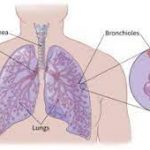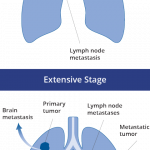The human respiratory system is consists of airways, lungs, and blood vessels. Lungs remove oxygen from the air and pass it into the blood. Lung cancer (SC) is an unrestricted and rapid growth of lung cells. Non-small cell lung cancer (NSCLC) and small cell lung cancer (SCLC) are two types of lung cancer.

About 15% of all lung cancers are SCLC or oat cell cancer. It overgrows and spreads faster than NSCLC. Around 70% of SCLC patients have cancer spread at the time of diagnosis. This cancer proliferates quickly. Hence, it responds well to chemotherapy and radiation therapy. Unfortunately, for many patients, cancer may reappear later.
Metastasis is when cancer cells spread to other organs (bone, liver, brain). The cancer cells in the other organ appear similar to the cells that started growing in the lungs.
What are the signs & symptoms of SC lung cancer?
Symptoms of SC lung cancer include fatigue (tiredness), cough, chest pain, appetite loss, and shortness of breath (Dyspnea).
What are the diagnostic tests for SC lung cancer?
- Chest x-ray: It helps to check cancer spread in the lungs by detecting the spots on the lungs. If any abnormal changes occur, then the doctor may recommend additional tests.
- CT scan: It’s a kind of x-ray that captures detailed images of your insides. CT scan helps to detect cancer spread.
- PET scan: The doctor puts a small amount of a low-level radioactive substance in the blood, which attaches to the cancer cells. A special camera helps to detect the areas of radioactivity. These scans can help to show the cancer spread. It helps to see the location of cancer spread.
- Bronchoscopy is a thin, lighted, flexible tube that passes into the bronchi through the mouth to find tumors. The tube helps to remove fluid or a piece of cancer to check the presence of cancer cells.
- Blood tests: Blood tests help the doctor know more about overall health.
- Lung biopsy: The doctor removes a small piece of tissue or fluid of the cancerous growth to check the presence of cancer cells. A biopsy is an accurate way to know the presence of cancer.
How advanced is my SC lung cancer?
Staging helps to find out the extent of cancer growth and spread through the layers of the lung wall. It identifies the area of cancer spread to the nearby organs or farther away organs. The staging helps to decide the suitable treatment for you.

Small-cell lung cancer has a two-stage system: limited stage and extensive stage.
- Limited stage: The cancer is in one lung and lymph nodes on the same side of the chest.
- Extensive stage: Cancer spreads to the other lung, lymph nodes on the other side of the chest, distant organs, or fluid around the lungs.
What are the suitable treatments for me?
For a limited stage, radiation or chemotherapy (chemo) treatments are suitable for curing cancer. An extensive stage cancer is treatable but probably not curable. Ask your doctor about the lung cancer stage and what to expect. Listed below are the treatments for NSC lung cancer:
SURGERY
In most cases, surgery is not beneficial for small cell lung cancer. It helps to cure or control only early-stage cancer. It is a standard treatment option to curb lung cancer if not spread outside the lungs. The doctor may remove the affected part or whole part of the lung.
If fluid accumulates in the chest, it may cause breathing problems. The doctor will drain out the liquid with the help of a tube and put a drug into the tube to seal the space. It prevents the fluid from building up.
The common side effects of SC lung cancer surgery are cough, lung pain, bronchopleural fistula, and collapsed lungs. Ask the doctor if you have problems.
RADIATION Therapy
Radiations are high-energy rays. It helps to shrink the tumor and kills cancer cells. Radiation is effective along with chemo in limited-stage small-cell lung cancer. It treats the tumor and chest lymph nodes. It prevents cancer spread. Radiation is beneficial after surgery for non-small cell lung cancer. Radiation may relieve bleeding, trouble swallowing, or other problems when the lung cancer has grown extensively or has spread to other organs. The doctor prescribes small doses every day for several weeks.
The common side effects are fatigue, sunburn-like skin change, appetite loss (anorexia), nausea, and vomiting (emesis).
Most side effects may get better after radiation ends. Ask your doctor about how to deal with the side effects.
CHEMOTHERAPY
It is a primary treatment for small-cell lung cancer. The medicines are given intravenously or orally. Sometimes it is given intravenously. These medicines spread through the body via the blood. The doctor schedules chemotherapy in cycles or rounds. Each cycle is followed by a rest time which helps the body recover from side effects. Most of the time, the doctor recommends two or more chemo medicines. Treatment lasts for a few months. Chemo is beneficial if cancer has spread to other organs.
The common side effects are fatigue (tiredness), loss of appetite, body pain, and hair loss. The side effects go away after chemo treatment ends. Seek help from your doctor for any side effects.
IMMUNOTHERAPY
It enhances your immune system to attack small cell lung cancer. Immunotherapy medicines are given intravenously or taken as pills.
The common side effects are fatigue, cough, nausea, excessive itching (pruritus), skin rash, appetite loss, constipation, joint pain (arthralgia), and diarrhea (dysentery). Most of these side effects go away after treatment ends. Talk to your cancer care team about side effects.
What are the other treatment options?
The other treatment options may or may not be standard medical treatments. These treatments include vitamin supplements, herbal remedies, and diet. Talk to your doctor about other treatment options.
What to expect after treatment?
You may have fear of cancer recurrence. Visit your doctor every three months after the treatment ends. Do not skip follow-up visits. Your doctors will ask you about new symptoms. A physical examination and diagnostic tests may help to check recurrence.
For the first year, the follow-up visits may be every three months. After the first year, follow-up visits might be every six months, and then at once a year after five years.
After treatment, visits maybe every three months for the first year. You may have several diagnostic tests. After the first year, visits might be every six months, and then at least once a year after five years.
Dealing with cancer treatment is challenging. It can be a time to think about improving your health. Visit us at https://ankr.us or Dealing with cancer is challenging. Ankr can help you find the best treatment and cut side effects by half! Sign up for free 30-day trial now (https://my.ankr.us/patientSignup) Ankr is the useful Cancer Platform in and around the USA. It offers the best modern treatment for cancer. Hence, improving the quality and life expectancy of the cancer patients.
